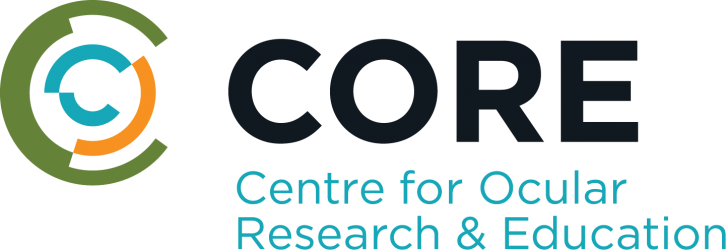Jump to:
Peer-reviewed articles
2025
Ngo,W., Nagaarudkumaran,N., Huynh,C. B.
Refrigeration reduces instillation discomfort of a 0.09% cyclosporine A solution
Optometry and Vision Science 2025;102(1):14-19
[ Show Abstract ]
Significance: Topical cyclosporine A (CsA) for the treatment of dry eye disease is often associated with instillation discomfort, which may negatively influence patient adherence to therapy. This study found that refrigerating topical CsA reduced instillation discomfort compared with instillation of warm CsA. Thus, refrigerating CsA prior to instillation may improve patient experience when using CsA to manage dry eye disease.
Purpose: This study aimed to quantify instillation discomfort associated with cold or warm instillation of a 0.09% CsA.
Methods: Forty participants with symptomatic aqueous deficient dry eye were enrolled. A drop of cold (4°C) CsA was instilled in one eye, and a drop of warm (23°C) CsA was instilled in the other eye. The order and eye receiving the cold drop were randomized. Participants rated the discomfort of each eye (0, no discomfort; 10, maximal discomfort) prior to drop instillation, immediately post-instillation, and at each subsequent minute for 10 minutes. Area under the curve was used to quantify cumulative discomfort.
Results: Forty participants (39.6 ± 18.9 years old, 82% female) completed the study. A majority of participants (n = 24, 60%) experienced reduced cumulative discomfort with cold CsA, whereas the remainder experienced minimal difference (n = 10, 25%) or increased cumulative discomfort (n = 6, 15%). For those with reduced discomfort (n = 24), cumulative discomfort associated with cold instillation (median, 11.5 [2.2, 20.0]) was significantly lower (p<0.01) than cumulative discomfort associated with warm instillation (median, 17.5 [11.2, 32.2]). Cold instillation was associated with a median reduction of 1 discomfort point immediately post-instillation and at all subsequent time points (all p≤0.04, but not significant at t = 10), compared with warm instillation.
Conclusions: Up to 60% of participants found that cold instillation of CsA solution induced less discomfort than warm instillation, lasting up to 9 minutes post-instillation. In contrast, although 15% of participants found reduced discomfort with warm instillation, the magnitude of discomfort associated with warm instillation was not significantly different than cold instillation.
2023
Huynh,C. B., Nagaarudkumaran,N., Kalyaanamoorthy,S., Ngo,W.
In Silico and In Vitro Approach for Validating the Inhibition of Matrix Metalloproteinase-9 by Quercetin
Eye & Contact Lens 2023;49(5):193-198
[ Show Abstract ]
Purpose:
To validate the mechanism and inhibitory activity of quercetin against matrix metalloproteinase-9 (MMP-9) using a hybrid in silico and in vitro approach.
Methods:
The structure of MMP-9 was obtained from the Protein Data Bank, and the active site was identified using previous annotations from the Universal Protein Resource. The structure of quercetin was obtained from ZINC15. Molecular docking was performed to quantify the binding affinity of quercetin to the active site of MMP-9. The inhibitory effect of various concentrations of quercetin (0.0025, 0.025, 0.25, 1.0, and 1.5 mM) on MMP-9 was quantified using a commercially available fluorometric assay. The cytotoxicity of quercetin to immortalized human corneal epithelial cells (HCECs) was quantified by obtaining the metabolic activities of the cells exposed to various concentrations of quercetin for 24 hr.
Results:
Quercetin interacts with MMP-9 by binding within the active site pocket and interacting with residues LEU 188, ALA 189, GLU 227, and MET 247. The binding affinity predicted by molecular docking was −9.9 kcal/mol. All concentrations of quercetin demonstrated significant inhibition of MMP-9 enzyme activity (all P0.99).
Conclusions:
Quercetin inhibited MMP-9 in a dose-dependent manner and was well-tolerated by HCECs, suggesting a potential role in therapy for diseases with upregulated MMP-9 as part of its pathogenesis.
2022
Nagaarudkumaran,N., Mirzapur,P., McCanna,D. J., Ngo,W.
Temporal Change in Pro-Inflammatory Cytokine Expression from Immortalized Human Corneal Epithelial Cells Exposed to Hyperosmotic Stress
Current Eye Research 2022;47(11):1488-1495
[ Show Abstract ]
Purpose
To determine the metabolic activity, and cytokine expression over time from immortalized human corneal epithelial cells (HCECs) exposed to hyperosmotic stress.
Methods
HCECs were cultured and expanded in DMEM/F-12 with 10% FBS. The cells were exposed to either normal media (295 mmol/kg) or hyperosmolar media (500 mmol/kg) for 0.25, 3, 6, and 12 hours. After each exposure duration, metabolic activity was quantified using alamarBlue, and a panel of pro-inflammatory cytokines (IL-1β, IL-2, IL-4, IL-6, IL-8, IL-10, IL-12p70, IL-13, TNF-α, IFN-γ, and IL-17A) was quantified using multiplexed electrochemiluminescence (Meso Scale Diagnostics, Rockville, MD).
Results
Metabolic activity of the HCEC exposed to hyperosmolar conditions was significantly reduced at the 3-, 6-, and 12-hour mark compared to the control (all p < 0.01). There was no significant difference in cytokine expression between the hyperosmolar media and control at the 0.25- and 3-hour mark for all cytokines (all p ≥ 0.28). The difference in cytokine expression between the hyperosmolar media and the control was significant for IL-1β, IL-4, IL-6, IL-8, IL-12p70, IL-13, and TNF-α at the 6-hour mark (all p ≤ 0.02). No significant change in cytokine expression between the hyperosmolar media and control was noted for IL-2, IL-10, IL-17A, and IFN-γ (all p ≥ 0.74) at the 6-hour mark.
Conclusion
Hyperosmolar stress reduced cell metabolic activity and increased expression of IL-1β, IL-4, IL6, IL8, IL-12p70, IL-13, and TNF-α over a 6-hour period in an immortalized HCEC line.
Scientific Presentations
2024
Nagaarudkumaran N, Ngo W. Impaired Autophagy Dysregulates the Immune Response of the Corneal Epithelium under Hyperosmolar Stress American Academy of Optometry Meeting, Indianapolis, Nov 6, 2024 [ Show Abstract ]
Purpose: The regulation of inflammatory responses is imperative to the health of the ocular surface. Ocular aging can disrupt this regulatory process, thereby contributing to the decline of tissue function and the progression of ocular surface disease (OSD). OSD is associated with age and its core mechanism is inflammation; however, the cellular mechanism linking aging to inflammation remains elusive. A decline in autophagic function is a hallmark of cellular aging, and thus may be used to model ocular aging in vitro. The purpose of this study was to investigate the effect of impaired autophagy on the inflammatory responses from human corneal epithelial cells (HCEC) under hyperosmotic stress.
Methods: Immortalized HCEC were treated with an autophagy inhibitor, 5 mM 3-methyladenine (3-MA) or 100 µM chloroquine (CQ), for 24 hours. Untreated HCEC served as the control. Following the treatment period, HCEC were exposed to hyperosmolar media (500 mmol/kg via sodium chloride), or isomolar media (295 mmol/kg) for 6 hours. The cell supernatants were subsequently collected for inflammatory protein quantification. The pro-inflammatory cytokines interleukin (IL)-1β, IL-6, IL-8, and tumour necrosis factor (TNF)-α, and the immunoregulatory protein thrombospondin-1 (TSP-1) were quantified using electrochemiluminescence immunoassays. This experiment was conducted in technical replicates of three and was repeated three times. Inflammatory protein expression was normalized to the respective untreated HCEC control condition under either isomolar or hyperosmolar stress.
Results: Under hyperosmolar conditions, HCEC treated with either 3-MA or CQ exhibited a significantly lower expression of IL-1β (both p < 0.01), IL-6 (both p < 0.01), and TNF- α (both p 0.05). Under isomolar conditions, HCEC treated with either 3-MA or CQ exhibited no significant difference in IL-1β, IL-6, IL-8, and TNF-α expression when compared to untreated HCEC (all p > 0.06). Similarly, under hyperosmolar conditions HCEC treated with either 3-MA or CQ exhibited a significant reduction in TSP-1 expression in comparison to the untreated HCEC (both p < 0.01). Under isomolar conditions, HCEC treated with 3-MA or CQ, was also found to exhibit a significant reduction in TSP-1 expression compared to untreated HCEC (both p < 0.01).
Conclusion: This experiment found that disrupting autophagy alters the inflammatory response and its regulation associated with hyperosmolar stress. These findings suggest that aging reduces the ability of the corneal epithelium to control its response to inflammatory stimuli, potentially revealing a link between corneal aging and OSD.
Ngo W, Nagaarudkumaran N, Huynh C. Reducing Instillation Discomfort of a 0.09% Cyclosporine a Solution American Academy of Optometry Meeting, Indianapolis, Nov 8, 2024 [ Show Abstract ]
Purpose: To quantify the instillation discomfort associated with either cold or warm instillation of a cyclosporine A solution (0.09% CsA, Sun Pharmaceutical Industries Ltd., CA).
Methods: 40 participants with symptomatic aqueous deficient dry eye (Ocular Surface Disease Index >23, strip meniscometry< 5 mm) were enrolled. A drop of cold (4°C) 0.09% CsA was instilled in one eye, and a drop of warm (23°C) 0.09% CsA was instilled in the other eye. The order and eye receiving the cold drop was randomized. Participants were instructed to rate the discomfort of each eye (0=no discomfort, 10=maximal discomfort) prior to drop instillation, immediately post-instillation, and at each subsequent minute for 10 minutes (i.e., t=0, t=1, … t=10). Area under curve (AUC) was used to quantify cumulative discomfort (discomfort summed over time). Ocular surface staining (OSS), fluorescein tear breakup time (TBUT), and meibum quality (MG score) were obtained and correlated against difference in cumulative discomfort between cold and warm instillation. 0.09% CsA was stored at 4°C for 1 month and change in nanoparticle size (NanoSight, Malvern Instruments, UK) and pH was quantified.
Results: 40 participants (39.6 ± 18.9 years old, 82.5% female) completed the study. A majority of participants (n=24, 60%) experienced reduced cumulative discomfort with cold 0.09% CsA, while the remainder experienced minimal difference (n=10, 25%), or increased cumulative discomfort (n=6, 15%). For those with reduced discomfort (n=24), cumulative discomfort associated with cold instillation (median = 11.5 (2.2, 20.0)) was significantly lower (p< 0.01) than cumulative discomfort associated with warm instillation (median = 17.5 (11.2, 32.2)). Cold instillation was associated with a median reduction of 1 discomfort point immediately post-instillation, and at all subsequent time points (all p≤0.04, but not significant at t=10), compared to warm instillation. None of the clinical tests (OSDI, MG score, TBUT, OSS) correlated with difference in cumulative discomfort (all p≥0.38). There was no apparent change in mean nanoparticle size (Δ=-13.5 nm ± 29 nm; p=0.53) and pH (Δ=0.04 units; p=0.05) over 1 month of storage at 4°C.
Conclusion: A majority of participants found relatively reduced discomfort with cold instillation of 0.09% CsA solution, lasting up to 9 minutes post-instillation. No clinical signs were capable predictors of reduced discomfort. Nanoparticle size and pH appeared to be stable over 1 month of cold stora
2022
Nagaarudkumaran N, Mirzapur P, McCanna DJ, Jones L, Ngo W. The effect of Lifitegrast on cytokine response from immortalized human corneal epithelial cells under hyperosmolar stress American Academy of Optometry, San Diego, 2022 [ Show Abstract ]
Purpose: Lifitegrast is a topical ophthalmic pharmaceutical used to treat moderate to severe dry eye disease. Its mechanism of action occurs by inhibiting the binding between lymphocyte function-associated antigen 1 (LFA-1) and intercellular adhesion molecule 1 (ICAM-1). As an integrin antagonist, lifitegrast binds to LFA-1, preventing the formation of the LFA-1/ICAM-1 complex.
Given that lifitegrast is a small molecule with potential to act on other intracellular targets, this study aimed to examine its effect on the inflammatory response of immortalized human corneal epithelial cells (HCECs) undergoing hyperosmolar stress.
Methods: HCECs were exposed to hyperosmolar media (500 mmol/kg via sodium chloride) and treated with 1% or 3% lifitegrast. A treatment without lifitegrast was used as a control. Following an exposure period of 0.25-hours, 3-hours, 6-hours and 12-hours, the conditioned cell media was collected and cytokines IFN-γ, IL-1β, IL-2, IL-4, IL-6, IL-8, IL-10, IL-12p70, IL-13, TNF-α and IL-17A were quantified using electrochemiluminescent multiplexing assays.
Results: Cells exposed to 1% lifitegrast exhibited significantly lower IL-1β, IL-6, IL-8, and TNF-α compared to the control (all p < 0.0172) at 6-hours and lower IL-6, IL-8, and TNF-α (all p < 0.0053) at 12-hours. With the 3% lifitegrast exposure, there was a significant reduction in IL-1β, IL-6, IL-8, and TNF-α (all p < 0.0224) at 6 and 12-hours. By the 12-hour mark, IL-10, IL-17A, IFN-γ, and IL-2 were significantly higher in both 1% and 3% lifitegrast compared to the control (all p < 0.0254). IL-12p70 was significantly higher with 3% lifitegrast only at all time points (all p < 0.0146), and IL-4 was significantly higher with 3% lifitegrast only at 0.25 and 3-hours (both p < 0.0249) compared to the control. There was no significant difference in IL-13 concentration between 1% and 3% lifitegrast at any time point.
Conclusion: Lifitegrast reduced IL-1β, IL-6, IL-8, and TNF-α from HCEC exposed to hyperosmotic stress. However, lifitegrast also increased IL-10, IL-12p70, IL-17A, IL-2, IL-4, and IFN-γ. Therefore, in addition to LFA-1/ICAM-1 antagonism, it is possible that lifitegrast may function additionally to inhibit the innate immune response and promote suppressive immune function.
Nagaarudkumaran N, Mirzapur P, McCanna DJ, Jones L, Ngo W. The effect of Lifitegrast on the hyperosmotic stress-induced cytokine response from immortalized human corneal epithelial cells 10th Canadian Optometry School Research Conference, Montréal, Canada, Dec 3, 2022
Ngo W, Nagaarudkumaran N. Prediction and validation of an intracellular target for lifitegrast 10th Canadian Optometry School Research Conference, Montréal, Canada, Dec 3, 2022
2020
Nagaarudkumaran N, McCanna D, Ngo W, Jones L. In vitro quantification of cytokines adhered to contemporary contact lens materials The Association for Research in Vision and Ophthalmology, 2020 [ Show Abstract ][ PDF ]
Purpose : Contact lenses (CL) may induce a low-level inflammatory response on the ocular surface. Previous studies have quantified the concentration of inflammatory mediators present in the tear film during CL wear. Analyzing the inflammatory mediators loosely adhered to CL materials may provide another perspective on the role that contact lenses play in inflammation. The purpose of this in vitro study was to quantify a variety of cytokines found in the tear film that adhered to various CL materials and to develop a method that could extract them.
Methods : Cytokines IL-1β, IL-6, IL-8, and TNF-α (Meso Scale Diagnostics, Rockville, MD) were combined with 5 mL of Diluent 2 to prepare a cytokine solution with a final concentration of 119.41, 166.05, 101.48 and 40.73 pg/mL, respectively. Contact lenses (etafilcon A, somofilcon A, omafilcon A, delefilcon A) (n=4 each) were each placed into a polypropylene tube containing a volume of 200 μL of the prepared cytokine solution and were incubated at 23°C for 6 hours. The lenses were removed from the tubes using tweezers and placed into a 0.6 mL microcentrifuge tube containing 200 μL of Diluent 2 and were incubated at 23°C for 1 hour. The microcentrifuge tube was then vortexed for 5 seconds and pin sized holes were made at the base of the tube. The tube was then placed into a larger 2.0 mL microcentrifuge tube acting as a carrier and were centrifuged at 604 RCF. The eluent in the 2.0 mL microcentrifuge was then collected and stored at -80°C for cytokine quantification at a later date, using the MESO QuickPlex SQ 120 (Meso Scale Diagnostics, Rockville, MD). Statistical analysis was performed using a one-way ANOVA.
Results : There was no significant difference between cytokine concentrations for all CL materials (p>0.05).
Conclusions : While there were no significant differences between the concentrations of cytokines found loosely adhered to the soft CL materials investigated, the results support this method as a means to quantify such cytokines on soft lens materials. This method may be used to examine human-worn lenses in future studies.
This is a 2020 ARVO Annual Meeting abstract.
Professional Publications
2022
Nagaarudkumaran N. Fast forward to the future - potential future ocular drug delivery technologies Contact Lens Spectrum 2022;37, August: 14





